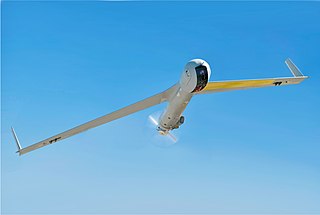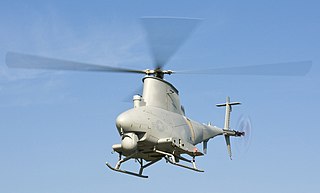
The AAI RQ-7 Shadow is an American unmanned aerial vehicle (UAV) used by the United States Army, Australian Army, Swedish Army, Turkish Air Force and Italian Army for reconnaissance, surveillance, target acquisition and battle damage assessment. Launched from a trailer-mounted pneumatic catapult, it is recovered with the aid of arresting gear similar to jets on an aircraft carrier. Its gimbal-mounted, digitally stabilized, liquid nitrogen-cooled electro-optical/infrared (EO/IR) camera relays video in real time via a C-band line-of-sight data link to the ground control station (GCS).

AAI Corporation is an aerospace and defense development and manufacturing firm, located in Hunt Valley, Maryland, US. Formerly a wholly owned subsidiary of United Industrial Corporation, AAI was acquired by Textron in 2007. It currently operates as a unit of Textron Systems and employs more than 2,000.

The Northrop Grumman MQ-4C Triton is an American high-altitude long endurance unmanned aerial vehicle (UAV) developed for and flown by the United States Navy as a surveillance aircraft. Together with its associated ground control station, it is an unmanned aircraft system (UAS). Developed under the Broad Area Maritime Surveillance (BAMS) program, the Triton is intended to provide real-time intelligence, surveillance and reconnaissance missions (ISR) over vast ocean and coastal regions, continuous maritime surveillance, conduct search and rescue missions, and to complement the Boeing P-8 Poseidon maritime patrol aircraft.

AeroVironment, Inc. is an American defense contractor headquartered in Arlington, Virginia, that designs and manufactures unmanned aerial vehicles (UAVs). Paul B. MacCready Jr., a designer of human-powered aircraft, founded the company in 1971. The company is best known for its lightweight human-powered and solar-powered vehicles. The company is the US military's top supplier of small drones —notably the Raven, Switchblade, Wasp and Puma models.

The Boeing Insitu ScanEagle is a small, long-endurance, low-altitude unmanned surveillance and reconnaissance aerial vehicle built by Insitu, a subsidiary of Boeing, and is used for reconnaissance. The ScanEagle was designed by Insitu based on the Insitu SeaScan, a commercial UAV that was intended for fish-spotting. The ScanEagle continues to receive improvements through upgrades and changes.

The Northrop Grumman MQ-8 Fire Scout is an unmanned autonomous helicopter developed by Northrop Grumman for use by the United States Armed Forces. The Fire Scout is designed to provide reconnaissance, situational awareness, aerial fire support and precision targeting support for ground, air and sea forces. The initial RQ-8A version was based on the Schweizer 330, while the enhanced MQ-8B was derived from the Schweizer 333. The larger MQ-8C Fire Scout variant is based on the Bell 407.

Swift Engineering is an American engineering firm that builds autonomous systems, helicopters, submarines, spacecraft, ground vehicles, robotics, and composite parts. The Chairman and CEO is Hiro Matsushita, a former racecar driver and grandson of the founder of Panasonic, Konosuke Matsushita.

Marine Unmanned Aerial Vehicle Training Squadron 2 (VMUT-2) is an unmanned aerial vehicle training squadron in the United States Marine Corps that is transitioning from operating the RQ-21A Blackjack to the MQ-9A Reaper. The squadron is based at Marine Corps Air Station Cherry Point in Havelock, North Carolina and will serve as the MQ-9A Reaper Fleet Replacement Squadron, training UAS officers and enlisted sensor operators. Historically, VMUT-2 provided aerial surveillance, offensive air support, and electronic warfare for the II Marine Expeditionary Force. VMUT-2 falls under the command of Marine Aircraft Group 14 and the 2nd Marine Aircraft Wing.

The General Atomics MQ-1C Gray Eagle is a medium-altitude, long-endurance (MALE) unmanned aircraft system (UAS). It was developed by General Atomics Aeronautical Systems (GA-ASI) for the United States Army as an upgrade of the General Atomics MQ-1 Predator.

Insitu Inc. is an American company that designs, develops and manufactures unmanned aerial systems (UAS). The company is a wholly owned subsidiary of The Boeing Company, and has several offices in the United States, the United Kingdom, and Australia. Its unmanned aerial vehicle (UAV) platforms—ScanEagle, Integrator, Integrator Extended Range (ER), ScanEagle 3 and RQ-21A Blackjack, have logged 1.3 million operational flight hours as of May 2022.

The AeroVironment T-20 unmanned aerial vehicle (UAV) is a medium range, composite aircraft capable of internal and external payloads. Launched from a portable catapult, it can be recovered with a shipboard landing system, or belly land on unimproved surfaces. The T-20 carries a retractable gimbal-mounted, digitally stabilized, electro-optical/infrared (EO/IR) camera that relays video in real time via a C-band LOS data link to the ground control station (GCS). Powered by a 4-stroke, fuel injected gasoline engine, the aircraft burns 2 lb (910 g) of fuel per hour at cruise. AeroVironment, Inc. acquired Arcturus UAV, the original developer of JUMP 20 and T-20 on February 22, 2021.

The Boeing Insitu RQ-21 Blackjack, company name Integrator, is an American unmanned air vehicle designed and built by Boeing Insitu to meet a United States Navy requirement for a small tactical unmanned air system (STUAS). It is a twin-boom, single-engine monoplane, designed as a supplement to the Boeing Scan Eagle. The Integrator weighs 61 kg (134 lb) and uses the same launcher and recovery system as the Scan Eagle.

The Unmanned Carrier-Launched Airborne Surveillance and Strike (UCLASS) was a United States Navy program to develop an autonomous carrier-based unmanned combat aerial vehicle providing an unmanned intelligence and strike asset to the fleet. After debate over whether the UCLASS should primarily focus on stealthy bombing or scouting, the Pentagon instead changed the program entirely into the Carrier-Based Aerial-Refueling System (CBARS) to create a UAV for aerial refueling duties to extend the range of manned fighters, which led to the Boeing MQ-25 Stingray.
The Northrop Grumman RQ-180 is an American stealth unmanned aerial vehicle (UAV) surveillance aircraft intended for contested airspace. As of 2019, there had been no images or statements released, but growing evidence points to the existence of the RQ-180 and its use in regular front-line service. The use of the nickname "White Bat" in a 2021 video released by the US Air Force Profession of Arms Center of Excellence (PACE) suggests that the military may be preparing to release information on the RQ-180.
Urban Air Mobility (UAM) is the use of small, highly automated aircraft to carry passengers or cargo at lower altitudes in urban and suburban areas which have been developed in response to traffic congestion. It usually refers to existing and emerging technologies such as traditional helicopters, vertical-takeoff-and-landing aircraft (VTOL), electrically propelled, vertical-takeoff-and-landing aircraft (eVTOL), and unmanned aerial vehicles (UAVs). These aircraft are characterized by the use of multiple electric-powered rotors or fans for lift and propulsion, along with fly-by-wire systems to control them. Inventors have explored urban air mobility concepts since the early days of powered flight. However, advances in materials, computerized flight controls, batteries and electric motors improved innovation and designs beginning in the late 2010s. Most UAM proponents envision that the aircraft will be owned and operated by professional operators, as with taxis, rather than by private individuals.

Aerovel Corporation was founded in 2006 by Dr. Tad McGeer, a designer of unmanned aerial systems (UAS) at various companies for more than 25 years. McGeer co-founded The Insitu Group in 1992, where he was the architect of Aerosonde, SeaScan and ScanEagle. Aerovel Flexrotor is the next evolution in McGeer's line of unmanned aerial systems. As of January 2024 the company is now owned by Airbus helicopters.

The Raytheon Coyote is a small, expendable, unmanned aircraft system built by the Raytheon Company, with the capability of operating in autonomous swarms. It is launched from a sonobuoy canister with the wings deploying in early flight phase.

Quantum-Systems GmbH is a German technology company headquartered in Gilching. Founded in 2015, it specializes in the development, design and production of small Unmanned Aircraft Vehicles (UAV), also known as drones.
The General Atomics Sparrowhawk is an unmanned parasite aircraft currently being developed by General Atomics Aeronautical Systems (GA-ASI). First disclosed in 2019 and revealed to the public in September 2020, the Sparrowhawk is intended to offer the United States Air Force a Small Unmanned Aerial System (sUAS) capable of SIGINT/ELINT, ISR, radar imaging, jamming and the possibility for future roles.
















